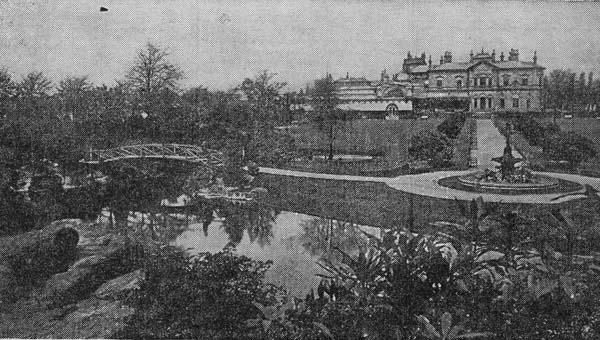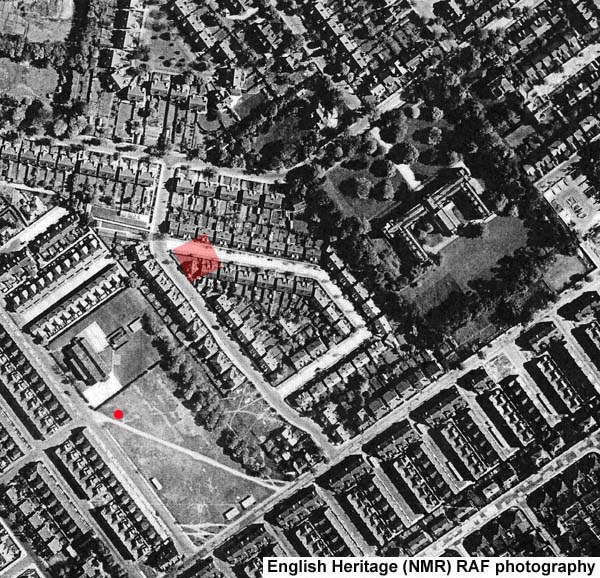Manley Hall


Manley Hall was the home
of the so-called "Merchant Prince" of Manchester's
Textile Industry, Sam Mendel. Mendel was an
enormously wealthy merchant who had a spectacular fall
from riches to rags in 1875. His claim to fame was
his ability to transport textiles to India and Australia
faster than his competitors around the Cape of Good
Hope. When the Suez Canal opened in 1869 his
commercial advantage faded away and in 1875 he was
forced into bankruptcy. This led to the sale of
Manley Hall and the 80 acres of land on which it stood,
in Whalley Range.
If you follow the links below you can see some images of Manley Hall from the collection at Manchester Central Library.
Manley Hall was a suitable home for a wealthy merchant inside and out. The house stood amidst a beautiful pleasure ground and inside the house was Mendel's collection of furniture and art work. In 1875 the auction house of Christie, Manson and Woods announced that, "they have received instructions from Sam Mendel, Esq., who is leaving Manchester, to sell by private contract the Manley Hall estate, consisting of about eighty acres of freehold land." This included, "The magnificent contents of Sam Mendel, Esq., which will be sold be auction by Messers. Christie, Manson, and Woods, on the premises, Manley Hall, on Monday, March 15, 1875, and the following days. " They added that the sale would include, "The entire collection of silver and silver-guilt plate, the collections of gold snuff-boxes, bonbonnieres, watches, carvings in agate, rock crystal, etc, old Sevres and the old Chelsea porcelain, drawings, and pictures will be removed to London and sold by auction by Messers. Christie, Manson, and Woods at their great rooms, King Street, St. Jame’s Square, London. The pictures, drawings, plate, etc., will be on view at Manley Hall until the commencement of the sale."
In the book, “Memorials of Christie’s: A record of art sales from 1766 to 1896”, you can see an account of the Manley Hall sale. "The numerous great picture sales of this year commenced with that formed by Sam Mendel, of Manley Hall, Manchester, a textile merchant. Mendel (who was of German origin) made no pretensions to being a great connoisseur, and did not collect works of art as a pursuit. He found himself a rich man, and he saw that other rich men in business, successful like himself, were displaying their wealth by buying pictures at high prices, and making their dwelling houses as magnificent with works of modern art as the aristocracy had always done with the pictures by the old masters." ... "The general high excellence of the Manley Hall collection is due to the eminent firm of Thomas Agnew and Sons; its entire dispersal occupied twenty-one days; the pictures were sold on April I4th-17th and 23rd-24th, and produced the total of £101, 184 - 14s. - 6d, which amount included:
3,050 guineas paid by Mr. Hermon (M.P. for Preston), for the highly interesting series of 271 drawings and sketches of Lord Clyde's campaign in Oude by Mr. E. Ltindgren ; and the residue of the collection, the furniture and other appointments of the Hall, sold on the premises on March I5th and fourteen following days, brought £42,855.
100 of the more important works changed hands by private treaty. The more important of the 137 pictures of the English school and 25 by foreign artists included:
J. Constable, “Landscape with a Suffolk river”, 28 x 36, 600 guineas ;
T. Gainsborough, “George IV. when Prince of Wales”, 28 x 24, 460 guineas
Sir F. Leighton, “Noble Venetian Lady”, 16th century, 34 x 25, 950 guineas ;
Sir John Millais, " O, Swallow, Swallow," painted in 1865, 40 x 29, 1,000 guineas, “Jephthah”, 1867, 50 x 64, 3,800 guineas and "Chill October," 1871, 55x73, 3,100 guineas
J. M. W. Turner, “View on the River Maas, Holland”, 22 x 36, 2,500 guineas, and “Grand Canal, Venice”, 36x48, 7,000 guineas; "
If you follow the links below you can see some images of Manley Hall from the collection at Manchester Central Library.
| Manley
Hall 1850 |
Manley
Hall 1892 |
| Manley
Hall 1905 |
Manley
Hall 1905 |
Manley Hall was a suitable home for a wealthy merchant inside and out. The house stood amidst a beautiful pleasure ground and inside the house was Mendel's collection of furniture and art work. In 1875 the auction house of Christie, Manson and Woods announced that, "they have received instructions from Sam Mendel, Esq., who is leaving Manchester, to sell by private contract the Manley Hall estate, consisting of about eighty acres of freehold land." This included, "The magnificent contents of Sam Mendel, Esq., which will be sold be auction by Messers. Christie, Manson, and Woods, on the premises, Manley Hall, on Monday, March 15, 1875, and the following days. " They added that the sale would include, "The entire collection of silver and silver-guilt plate, the collections of gold snuff-boxes, bonbonnieres, watches, carvings in agate, rock crystal, etc, old Sevres and the old Chelsea porcelain, drawings, and pictures will be removed to London and sold by auction by Messers. Christie, Manson, and Woods at their great rooms, King Street, St. Jame’s Square, London. The pictures, drawings, plate, etc., will be on view at Manley Hall until the commencement of the sale."
In the book, “Memorials of Christie’s: A record of art sales from 1766 to 1896”, you can see an account of the Manley Hall sale. "The numerous great picture sales of this year commenced with that formed by Sam Mendel, of Manley Hall, Manchester, a textile merchant. Mendel (who was of German origin) made no pretensions to being a great connoisseur, and did not collect works of art as a pursuit. He found himself a rich man, and he saw that other rich men in business, successful like himself, were displaying their wealth by buying pictures at high prices, and making their dwelling houses as magnificent with works of modern art as the aristocracy had always done with the pictures by the old masters." ... "The general high excellence of the Manley Hall collection is due to the eminent firm of Thomas Agnew and Sons; its entire dispersal occupied twenty-one days; the pictures were sold on April I4th-17th and 23rd-24th, and produced the total of £101, 184 - 14s. - 6d, which amount included:
3,050 guineas paid by Mr. Hermon (M.P. for Preston), for the highly interesting series of 271 drawings and sketches of Lord Clyde's campaign in Oude by Mr. E. Ltindgren ; and the residue of the collection, the furniture and other appointments of the Hall, sold on the premises on March I5th and fourteen following days, brought £42,855.
100 of the more important works changed hands by private treaty. The more important of the 137 pictures of the English school and 25 by foreign artists included:
J. Constable, “Landscape with a Suffolk river”, 28 x 36, 600 guineas ;
T. Gainsborough, “George IV. when Prince of Wales”, 28 x 24, 460 guineas
Sir F. Leighton, “Noble Venetian Lady”, 16th century, 34 x 25, 950 guineas ;
Sir John Millais, " O, Swallow, Swallow," painted in 1865, 40 x 29, 1,000 guineas, “Jephthah”, 1867, 50 x 64, 3,800 guineas and "Chill October," 1871, 55x73, 3,100 guineas
J. M. W. Turner, “View on the River Maas, Holland”, 22 x 36, 2,500 guineas, and “Grand Canal, Venice”, 36x48, 7,000 guineas; "
*****************************
The following article was
published in the City News on October 8, 1904
Manley Hall

******************

The Chadwick and Son - Orchids Inc. website features an article by A. A. Chadwick that says this about Mendel and Manley Hall, "A visit to the gardens at Manley Hall was a wonderful experience. Forty-four greenhouses traveled the spectrum of the whole plant kingdom — with winding walks and waterfalls as in a rich tropical valley of ferns, or stepping stones for walkways that connected a wonderland of artificial lakes filled with aquatic plants. Everything luxuriated in palms, cycads, and beautiful-leaved plants, but there was also a greenhouse full of flowering azaleas surrounded by beds of pansies.
Orchids were the specialty at Manley Hall, and the collection was a showcase of the finest orchid species and varieties of the day. The Cattleya species were particular favorites and when a representative of The Gardener’s Chronicle visited Manley Hall in the spring of 1871, he commented with admiration on a large dark Cattleya mossiae ‘Manley Hall’ with 16 flowers. When The Floral Magazine visited Manley Hall the following year, they wrote about a magnificent new Cattleya species that would excite the interest of the whole horticultural world for decades to come."
Manley Hall
The announcement that the
Manchester Education Committee has decided to
establish a training college for teachers at Manley
Hall will be welcomed by many who would regret to see
the building dismantled, and the adjacent land given
over entirely to the tender mercies of the
jerry-builder. Built by Sam Mendel, whose fame
as a merchant prince has not yet faded from the
memory, the Hall was furnished by him in a sumptuous
manner, the collection of pictures being particularly
fine. Overtaken by misfortune Mendel left
Manchester, and early in 1875 the furniture was
dispersed at a five day sale, producing about
£18,000. A few months later the gates of the
park were thrown open and the public was admitted to
enjoy its glories. In addition to the
magnificent show of rhododendrons and roses, extra
attractions were provided in the shape of the bands of
the Grenadier and Scots Fusilier Guards; and thousands
of visitors paid for admission.
In September of the same year one
of the most remarkable schemes ever drawn up was
presented to the people of Manchester. A company
was formed with a capital of half a million, and it
was proposed to purchase the hall and park and to
convert them into a great pleasure resort. A
winter palace was to be erected which should contain
an art gallery, concert hall, promenade, library,
assembly room, skating rinks, baths, and refreshment
rooms. Shareholders were to be allowed to use
the park for promenade purposes on Sundays, and the
hall was to be converted into a club, membership of
which should be limited to holders of one hundred or
more shares in the company. Admission to the
entertainments to be provided was to be by single
payment or subscription. Subscriber’s tickets
were to to be issued at three guineas, but
shareholders were to secure them for one guinea.
In connection with the pavilion there was to be an art
union which was to distribute 2,500 prizes annually,
and those purchased for the first draw were estimated
to be worth £50,000. No money dividends were to
be paid, but surplus profits were to be expended in
pictures for prizes in connection with the union.
Such was the scheme drawn up by
Francis Fuller and supported on the prospectus by many
of the best known Manchester men of thirty years
ago. This was early in September, 1875. At
once difficulties arose, and protests were made that
names had been published without consent; and in a
week from the date of issuing the prospectus the
scheme was killed. A meeting of those interested
was held, but nothing was done; and on October 1 and
advertisement announced the resumption of possession
by Ellis Lever. During the month that the
proposal was before the people of Manchester it was
exposed to the most scathing criticism in the columns
of the local press, and satire was resorted to in
other ways. A most amusing skit was published
purporting to be the prospectus of the “Fuller’s Earth
Company, capital £500,000. the council, committee,
treasurer, surveyor, governor and general factotum of
which was Funny Fuller, with offices at Colney Hatch,
Hanwell and Prestwich.” The wording of the
prospectus is the most amusing reading printed in
Manchester for many years. So ended Francis
Fuller’s scheme. In November of the same year
that gentleman called a meeting of his creditors, to
whom he disclosed liabilities amounting to £14,151,
and assets estimated to produce £963.
In following year another scheme
was promulgated. The capital was to be £120,000
and it was proposed to convert the hall and the park
into a holiday and pleasure resort, with winter
garden, concert room, gymnasium, skating rink, and so
on. For two years the company continued to
exist. At the end of that period £77,083 was
still owing to the vendor, and £11,809 had been lost
on the management of the gardens; and in January,
1879, a petition for the compulsory winding up of the
company was heard in the Chancery Court at the
instance of Sam Mendel. A few months later the
estate was offered for sale by public auction and was
disposed of to Mr. Mendel for the sum of £85,000, the
indebtedness of the company being £80,000. Thus
ended the second attempt made to convert the estate
into a pleasure resort.
In
February, 1880, a memorial, signed by numerous
ratepayers, was prepared urging upon the
Corporation to secure the park for recreation and
art culture purposes. The memorial was
presented to the Council on April 29 .....
The proposal never got beyond the initial stage
and for twenty years the park space has been
gradually reduced by building operations until one
had despaired of any portion being reserved from
the advance of bricks and mortar." -
T. Swindells
The map extract
below is dated 1905, thirty years after the process
of selling off the estate had begun. The house
is still there and it does sit on a large piece of
land but you can see the houses and the school that
had been built on the rest of the land. It was
in 1905 that the house was demolished.

The aerial image below was taken in 1953 and clearly houses have filled in the park. Today Manley Park is the small recreation ground marked on the image by a red dot. The red rectangle shows the approximate position of the hall itself.

The aerial image below was taken in 1953 and clearly houses have filled in the park. Today Manley Park is the small recreation ground marked on the image by a red dot. The red rectangle shows the approximate position of the hall itself.

******************
One of Sam
Mendel's passions was orchids and the Cattleya
mendelii orchid is named after him.

The Chadwick and Son - Orchids Inc. website features an article by A. A. Chadwick that says this about Mendel and Manley Hall, "A visit to the gardens at Manley Hall was a wonderful experience. Forty-four greenhouses traveled the spectrum of the whole plant kingdom — with winding walks and waterfalls as in a rich tropical valley of ferns, or stepping stones for walkways that connected a wonderland of artificial lakes filled with aquatic plants. Everything luxuriated in palms, cycads, and beautiful-leaved plants, but there was also a greenhouse full of flowering azaleas surrounded by beds of pansies.
Orchids were the specialty at Manley Hall, and the collection was a showcase of the finest orchid species and varieties of the day. The Cattleya species were particular favorites and when a representative of The Gardener’s Chronicle visited Manley Hall in the spring of 1871, he commented with admiration on a large dark Cattleya mossiae ‘Manley Hall’ with 16 flowers. When The Floral Magazine visited Manley Hall the following year, they wrote about a magnificent new Cattleya species that would excite the interest of the whole horticultural world for decades to come."